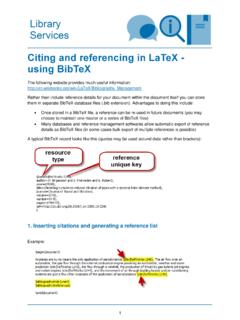Transcription of Portfolio Optimisation Using Value at Risk
1 Portfolio Optimisation Using Value at Risk Project Report by Vinay Kaura A project report submitted as partial fulfilment of the requirements for the degree of Computing (Computational Management) MEng Imperial College London Project Supervisor: Prof. Ber Rustem Second Marker: Panayiotis Parpas Project Website: ~vk02/project - i - Abstract optimal portfolios are normally computed Using the Portfolio risk measured in terms of its variance. However, performance risk is a problem if the Portfolio does not perform well. This project involves Using linear programming techniques to define and handle the Value -At-Risk risk metric. By evaluating historical prices to create future scenarios one can determine the Value -At-Risk of a specified Portfolio . Using linear programming software to develop a returns model for the FTSE 100 one can, hence, calculate which stocks should be bought or sold in order to minimise the Value -At-Risk of a Portfolio with an underlying required returns constraint.
2 The developed tool will look at multi-period scenarios and seek to optimise the Portfolio accordingly. This report documents the analysis of current ways of measuring single period Value -At-Risk and the formulation of a unique method of calculating multi-period Value -At-Risk . It goes on to describe an application which implements this model and highlights the results of exhaustive testing of the application. Ultimately, Using back testing, this report demonstrates how the developed model would have, hypothetically, been able to make profits of up to 40% over the course of the past year while the FTSE 100 benchmark rose by only 27%. Great stocks are extremely hard to find. If they weren't, then everyone would own them. - Philip A. Fisher - ii - Acknowledgements Throughout the duration of this project Professor Ber Rustem has been a brilliant project supervisor and his vast array of knowledge has been a great help in times of need.
3 I am also very grateful for the advice given by Panayiotis Parpas during my project. For the assistance given in setting up of batch jobs and discussing technical implementation techniques I would like to thank Duncan White from CSG. I would also like to thank Rezwan Ud-Din, from Goldman Sachs, who took time out of his busy schedule to test my final application. - iii - Table of Contents 1. Introduction Introduction & Motivation .. 1 Project Objectives .. 3 Key Contributions .. 3 2. Background Research Value At Risk and Current Implementations .. 4 Conditional Value At Risk .. 8 Multi-period Scenario Generation & Portfolio Multi-period Optimisation ..13 Efficient Frontier ..14 3. Specification Core Requirements Core Requirements Front-End Specification ..16 Core Requirements Back-End Specification.
4 17 Non-Core Requirements ..17 Extensions ..18 Documentation Requirements ..18 Implementation Requirements ..19 Summary of Requirements ..19 4. System Design System Overview ..20 Component Organisation ..22 Graphical User Interface ..23 5. System Implementation Implementation Languages ..25 The Database Database Implementation ..25 Database Structure ..27 Database API ..28 The Data Downloader Data Source ..29 Data Acquisition ..29 Parameters Re-calculation ..30 Job Automation ..30 The Scenario Generator Cluster ..30 Java Wrapper ..31 The Optimiser Optimisation Library Selection ..33 Interlinking the Optimisation Library with the Application ..34 Optimiser Wrapper ..35 The Graphical User Interface Interface Concepts ..37 - iv - Application Graphical User Interface.
5 37 Current Portfolio Composition & Parameters Panel ..39 Scenario Tree Panel ..41 Optimised Portfolio Panel ..42 Portfolio History Panel ..45 Historical Asset Prices Panel ..45 Back Testing Panel ..46 JFreeChart Graphs ..47 The Back Tester ..48 6. Project Management Source Control ..49 Time Management ..49 7. Testing & Evaluation Model Verification Individual Optimisations ..51 Back Testing ..52 Efficient Frontier ..55 Validation of the Interface and System Features ..56 End User Testing: Demonstration to Goldman Sachs ..58 Summary ..59 8. Conclusion Remarks ..60 Future Work ..60 9. References ..61 10. Appendix Section A: Stored Procedures ..62 Section B: Example Auto-Generated Optimisation Output File ..63 Section C: Feedback Email From Rezwan Ud-Din.
6 64 Section D: User Guide ..66 - 1 - Chapter 1 Introduction Introduction & Motivation Before looking at Value at Risk (VaR), we need to firstly define what risk is and, secondly, why we require a method to measure it. With regards to this project, risk is a measure of how volatile an asset s returns are. Exposure to this volatility can lead to a loss in ones investments. For this reason tools are used not only to passively measure and report risk, but also to defensively control or actively manage it. As stated in [6] and [7], there have been several large publicised losses in the 1990s, all of which have highlighted the need for accurate risk measure and control. These have included: In February 1993, Japan s Showa Shell Sekiyu oil company losing $ from speculating on exchange rates.
7 In December 1993, MG Refining and Marketing reporting a loss of $ from failed hedging of long-dated oil supply commitments. In December 1994, California s Orange County announcing losses from repos and other transactions totalling $ In February 1995, Nick Leeson, a trader from Britain s Barings PLC, losing $ from unauthorised Nikkei futures trading. After such events regulators have sought to defensively control the risk institutions take. They aim to find a balance between setting out a comprehensive set of regulations to identify institutions who take on excessive risk, while not introducing too rigid a system. VaR is a popular method which regulators use to assess risk. For example, the Basle Committee1 has sanctioned institutions to use internal VaR models for capital requirements2.
8 VaR is also used by institutions themselves. It is commonly used for self-regulation in the following manner: Benchmark Measure To provide a company-wide yardstick to compare risks across different markets. Potential Loss Measure To give a broad idea of the worst loss an institution can incur. Equity Capital To set a capital cushion for the institution. When managed properly, VaR can provide a controlled way of getting high returns on ones investments. In March 2006, David Viniar, Chief Financial Officer from the investment bank Goldman Sachs, stated that the firm s VaR rose from $80million in the previous quarter to $92million (+15%), which allowed the firm to increase its net income by 64%. 1 Committee set up by the Bank of International Settlements and based in Basle.
9 It drew up international capital adequacy standards for banks. As stated on 2 Rules to identify how much risk the bank is exposed to and then make sure if it loses money then it has enough in reserves to cover these losses. As stated in [18]. - 2 - However, rather than just Using VaR to measure the risk of institutions as a whole, it is also used by institutions in Portfolio Optimisation techniques to actively manage their risk. This is the focus of my project. Modern Portfolio Theory models the return of an asset as a random variable and a Portfolio as a weighted combination of these assets1. This implies that the return of a Portfolio is thus also a random variable and consequently has an expected Value and a variance. Risk in this model is normally identified with the variance of Portfolio return.
10 However, for the purposes of my project, VaR will be used to define the risk of portfolios. The main problem with variance is that it does not take into consideration the direction of an investment's movement. An asset could be volatile because its price rises quickly, however investors are not distressed by gains! For investors, risk is about the odds of losing money, and VaR is based on that common-sense fact. By assuming that investors care about the odds of big losses, VaR can be used to answer the questions, "What is my worst-case scenario?" or "How much could I lose in a really bad month?" The VaR statistic has three components: a time period, a confidence level and a loss amount (or loss percentage). It can thus be used to answer question such as: What is the most I can (with a 95% or 99% level of confidence) expect to lose in pounds over the next month?











